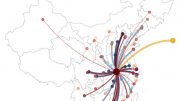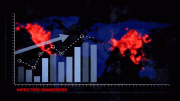
Researchers found that COVID-19 was already widespread in Wuhan, China, and Seattle, Washington, weeks before the cities implemented lockdown measures.
Patients with undiagnosed flu symptoms who actually had COVID-19 last winter were among thousands of undetected early cases of the disease at the beginning of this year. In a new paper in The Lancet’s open-access journal EClinicalMedicine, epidemiological researchers from The University of Texas at Austin estimated COVID-19 to be far more widespread in Wuhan, China, and Seattle, Washington, weeks ahead of lockdown measures in each city.
In the U.S., about a third of the estimated undiagnosed cases were among children. The researchers also concluded that the first case of COVID-19 in Seattle may have arrived as far back as Christmas or New Year’s Day.
Lauren Ancel Meyers, a professor of integrative biology and statistics and data sciences who leads the UT Austin COVID-19 Modeling Consortium, worked with her team of researchers to extrapolate the extent of the COVID-19 epidemic in Wuhan and Seattle based on retested throat swabs taken from patients who were suffering from influenza-like illnesses during January in Wuhan and during late February and early March in Seattle. When the samples were analyzed later in each city, most turned out to be flu, but some turned out to be positive for SARS-CoV-2, the virus that causes COVID-19.
“Even before we realized that COVID-19 was spreading, the data imply that there was at least one case of COVID-19 for every two cases of flu,” Meyers said. “Since we knew how widespread flu was at that time, we could reasonably determine the prevalence of COVID-19.”
When the Chinese government locked down Wuhan on Jan. 22, there were 422 known cases. But, extrapolating the throat-swab data across the city using a new epidemiological model, Meyers and her team found that there could have been more than 12,000 undetected symptomatic cases of COVID-19. On March 9, the week when Seattle schools closed due to the virus, researchers estimate that more than 9,000 people with flu-like symptoms had COVID-19 and that about a third of that total were children. The data do not imply that health authorities were aware of these infections, rather that they may have gone unseen during the early and uncertain stages of the pandemic.
“Given that COVID-19 appears to be overwhelmingly mild in children, our high estimate for symptomatic pediatric cases in Seattle suggests that there may have been thousands more mild cases at the time,” wrote Zhanwei Du, a postdoctoral researcher in Meyers’ lab and first author on the study.
According to several other studies, about half of COVID-19 cases are asymptomatic, leading researchers to believe that there may have been thousands more infected people in Wuhan and Seattle before each city’s respective lockdown measures went into effect.
“We can go back and piece together the history of this pandemic using a combination of investigative techniques and modeling,” Meyers said. “This helps us understand how the pandemic spread so quickly around the globe and provides insight into what we may see in the coming weeks and months.”
The new technique for estimating the amount of unseen COVID-19 based on the ratio of influenza cases to COVID-19 cases has also been used to determine how many children were actually infected in each city and the pace of the early pandemic in the U.S., Meyers said.
The finding in the new paper is consistent with work that Meyers and her team have done on the virus’s early spread. Using travel data, she and her team estimated how far the virus had spread and concluded that there were as many as 12,000 cases of COVID-19 in Wuhan before the lockdown.
Reference: “Using the COVID-19 to influenza ratio to estimate early pandemic spread in Wuhan, China and Seattle, US” by Zhanwei Du, Emily Javan, Ciara Nugent, Benjamin J. Cowling and Lauren Ancel Meyers, 12 August 2020, EClinicalMedicine.
DOI: 10.1016/j.eclinm.2020.100479
In addition to Meyers and Du, graduate students Emily Javan and Ciara Nugent at The University of Texas at Austin and professor Benjamin J. Cowling of the University of Hong Kong contributed to the research. The research was funded by the National Institutes of Health.









Is The Lancet still credible?
Is this at all surprising? You have to be very naive to not realize that China was hiding info from the very beginning.
Yup and we Seattleites were in cahoots with them all along so we could infect the red states and obstruct the awesomeness that is Trump on behalf of our Lizard people overlords! Jesus John, you have to see that it is far more likely that, like America, China didn’t recognize this never before seen virus rather than it being some diabolic plot to infect the world hatched in their communist volcano lair, right?! I think you do because I believe you are an intelligent guy. Even though I don’t know you I’m giving you the benefit of the doubt, which is a practice we Americans need to get better at.
Thanks, Doug, for revealing the insidious conspiracies of Seattle against the world. Ha ha ha!
The Crown, Covid, Corona fake virus is an illusion by the powers that be that control this world. It’s as fake as outer space. These liars know they cannot get through the Firmament.
Which winter? Norther winter or Southern winter? Need to be more accurate!